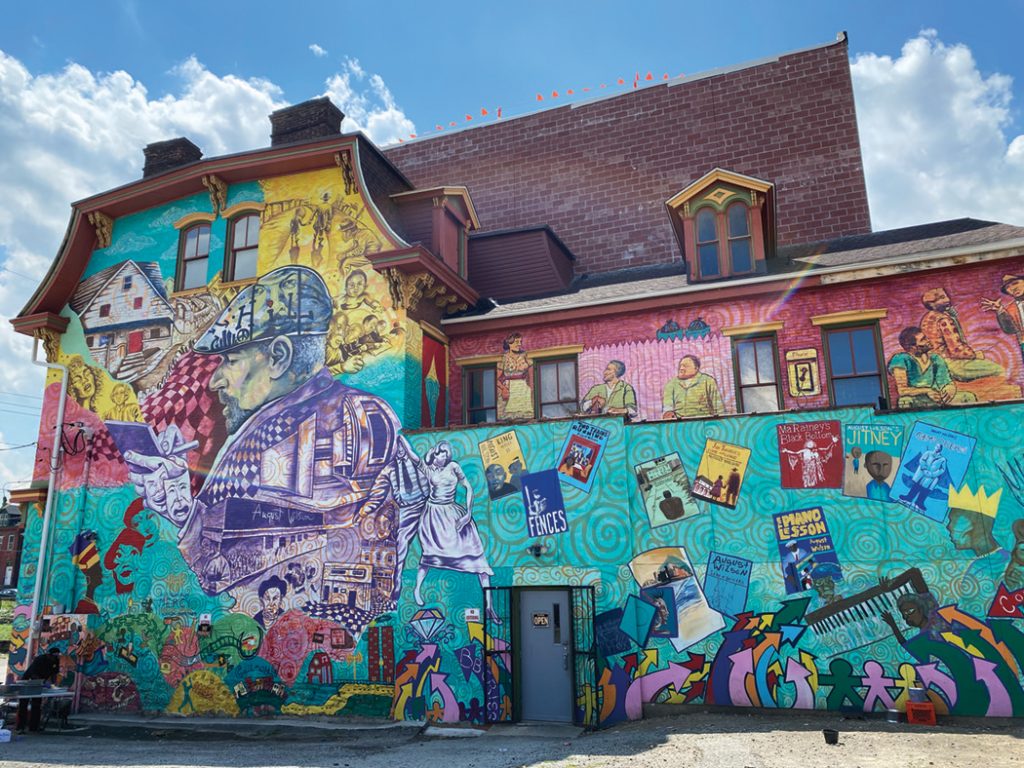
About the Plan
Introduction
Tourism is a powerful force in the growth and development of the regional economy, developing employment opportunities for residents and driving community improvements. The Tourism Development Plan places a greater emphasis on ensuring tourism delivers even stronger benefits to the community as it works towards increasing total economic impact to both the City of Pittsburgh and Allegheny County. The development of tourism across all neighborhoods is vital to improving and growing the visitor experience while supporting the overall quality of life for Pittsburghers.
The Tourism Development Plan provides a roadmap for the management and marketing of tourism in the destination moving forward by VisitPittsburgh and partners based on an assessment of tourism assets and experiences, target audiences, and community aspirations. Today, culinary experiences, sightseeing, outdoor activities, and museums are key competitive advantages. Sports continue to shape Pittsburgh’s identity as a destination. Outdoor activities represent a development opportunity to meet growing consumer demand for visitors to further enjoy the city’s riverfront and extensive trail network systems. Pittsburgh’s rich cultural heritage and institutions are key assets to develop and market in order to attract new audiences. Overall perceptions of Pittsburgh by both visitors and residents are positive – it’s perceived mainly as fun and welcoming, historical and authentic, and beautiful. Most visitors have a good perception of Pittsburgh as a place to visit, and residents also recognize the importance of tourism to the local economy and agree that the industry positively impacts the community’s quality of life.
The future brings enormous opportunities for the development of tourism in the City of Pittsburgh and Allegheny County.
Project Background
In the summer of 2022, VisitPittsburgh embarked on the development of a Tourism Development Plan to identify priorities over the next decade that would enable the City and Allegheny County to deliver a positive visitor experience while enhancing the quality of life for local residents and workers.
Resonance Consultancy and partner HVS (‘the project team’) were engaged to carry out industry and trends research, destination benchmarking, and stakeholder engagement in order to inform the creation of the tourism development plan. This approach was specifically designed to help VisitPITTSBURGH, the City of Pittsburgh, Allegheny County, and various industry and community-based organizations articulate and share a clear vision for the future.

The findings from this phase are summarized in a comprehensive Situational Analysis report. The report outlines the current state of tourism in Pittsburgh and Allegheny County, its strengths and weaknesses as a destination based on current market trends, and the key opportunities and issues that should be addressed in the Pittsburgh Tourism Development Plan.
As such, the project team embarked on a comprehensive stakeholder engagement exercise, which included a combination of 1-on-1 interviews and focus groups with over 100 industry professionals. These ranged from city leadership and government officials to the convention center, hotels, cultural attractions, non-profit advocacy groups and organizations, and tourism business operators. The primary purpose of these discussions was to identify stakeholder opinions, aspirations and ideas for the future of Pittsburgh as a destination, while also building an informal group of “champions” for the Destination Master Plan who will support endorsement and implementation of projects in the Plan.
In addition, the project team also distributed two surveys:
Community Survey to identify and define general attitudes towards living in Pittsburgh and Allegheny County, and tourism’s impact on resident quality of life (total responses: 1,784 residents).
Visitor Survey to identify and gauge previous visitors’ travel habits, preferences, and perceptions of Pittsburgh (total responses: 1,147 travelers, who previously visited Pittsburgh).
Findings from Phases 1 and 2 were shared and presented at four interim visioning workshops in October 2022, attended by more than 50 industry stakeholders. Attendees were then invited to participate in roundtable exercises to identify, develop and articulate project ideas and recommendations that would help address the various issues, opportunities, and challenges facing Pittsburgh’s travel and tourism industry.
Recommendations set forth in this Destination Master Plan are organized across various areas of opportunity that speak to the management of the visitor experience in key areas such as transportation, accommodation, visitor activities and facilities, and industry workforce.
As such, the project team co-developed an Action Plan with VisitPITTSBURGH and its partners to use in managing and monitoring the implementation of the Tourism Development Plan over the next 10 years.

Vision
Pittsburgh welcomes the world to enjoy a neighborly, unconventional, and unfiltered experience. With more than 90 unique neighborhoods – and 446 bridges – Pittsburgh is a city of multitudes. Diversity and acceptance is who we are.
Beyond the City, Allegheny County’s mountains, rivers, and parks are a unique playground for active adventurers year-round, while urban enthusiasts gather to celebrate legendary sports teams, enjoy local crafts, and diverse arts and culture. The region’s long history of innovation is a model to other destinations – from glass to steel, and life sciences to robotics – attracting future-focused events and innovative businesses.
In Pittsburgh, expect the unexpected, experience multitudes.
Audience Segments
A key approach to the development of this Tourism Development Plan was to identify and analyze the perceptions, needs, and interests of local residents, regional and drive-market visitors, and overnight business and leisure travelers in order to understand who visits Pittsburgh and why. These comprise a combination of current and aspirational demographics and psychographics.
By looking at Pittsburgh from the perspective of these audiences, strategies and actions were then identified to cater to the needs and interests of these specific groups. This market-driven approach provides focus to the planning process and will also help inform future marketing efforts as well. Understanding how the local community wants Pittsburgh to be positioned and developed as a live-, work-, and play destination is critical to the success of the Tourism Development Plan.
Overall, they are price-aware and educated visitors open to impulse trips and purchases within their means. They have also connected consumers, comfortable with technology, and are focused on convenience when making trip decisions and purchases.
Growing up in a region with a multitude of access to the outdoors, locals are environmentally conscious and are familiar with and enjoy participating responsibly in the great natural landscapes of Allegheny County. They are also culture enthusiasts and take great pride in all the city has to offer.
Today, residents perceive Pittsburgh as historical and fun, and value its beauty and welcoming community. Furthermore, they also perceive the region to be creative and diverse and defined by its quality of life.
The dining options in the city and the county, the overall access to the outdoors (nature and parks, and outdoor activities), the access to arts and culture, and events and festivals are the most important aspects when deciding to live/work/study in Pittsburgh.
While daily life and weekday routines are busy, this down-to-earth group is generous when it comes to spending weekends on experiences they grew up with, including spending time in the city for major league games and cultural events.
Many lead a suburban or semi-rural lifestyle, and like Allegheny County residents, are active in outdoor pursuits like hunting and fishing. As older Gen Xers, many are beginning to enjoy the transition from child-rearing to retirement and are looking forward to reconnecting with their neighborhoods and communities, exploring attractions near home, and supporting local businesses – albeit on a budget.
Both sets of visitors enjoy good food and wine, plus the amenities of a city’s cultural events and year-round entertainment offerings.
While those living within major metropolitan cities are familiar with and embrace the intricacies and grit of urban places, including riding public transportation, exploring diverse neighborhoods, and interacting with new and diverse communities, suburban families generally look for safe, comfortable, and more traditional travel experiences and favor convenient domestic driving vacations over plane trips.
Visitors from the drive market are educated and connected consumers who make full use of the advantages of mobile devices. Professional young couples or single households from major cities, in particular, have more time to focus on their interests and are more likely to take longer weekend escapes to destinations that offer a differentiated experience from busy urban life. Allegheny County is perfect for this group when packaged as an urban-rural destination with easy access to the great outdoors and steeped in rich history from the civil war to the industrial revolution.
Pittsburgh’s main domestic origin markets include mainly cities up and down the East Coast, including Philadelphia, New York, Atlanta, Charlotte, Orlando, and other cities such as Chicago. When compared with these urban destinations, Pittsburgh may be a ‘smaller’ city and its draw to fly market visitors lies more in its approachability, neighborliness, and unconventional traits. These far-reaching travelers are looking for the quirky and out-of-the-ordinary in Pittsburgh—particularly in the arts, heritage, entertainment, and culinary experiences. As educated and sophisticated consumers, they are also going to expect higher levels of digital integrations with in-person experiences and seamless or convenient travel experiences.
A core strength of Pittsburgh that will continue to grow the international leisure travel market demand, however, is in its low sales tax rates that create value for-money shopping experiences, particularly for the Canadian-Chinese audience. Fly market travelers are ultimately big spenders, with more than 75% of spending represented by receipts at the lodging and restaurants/bars.
